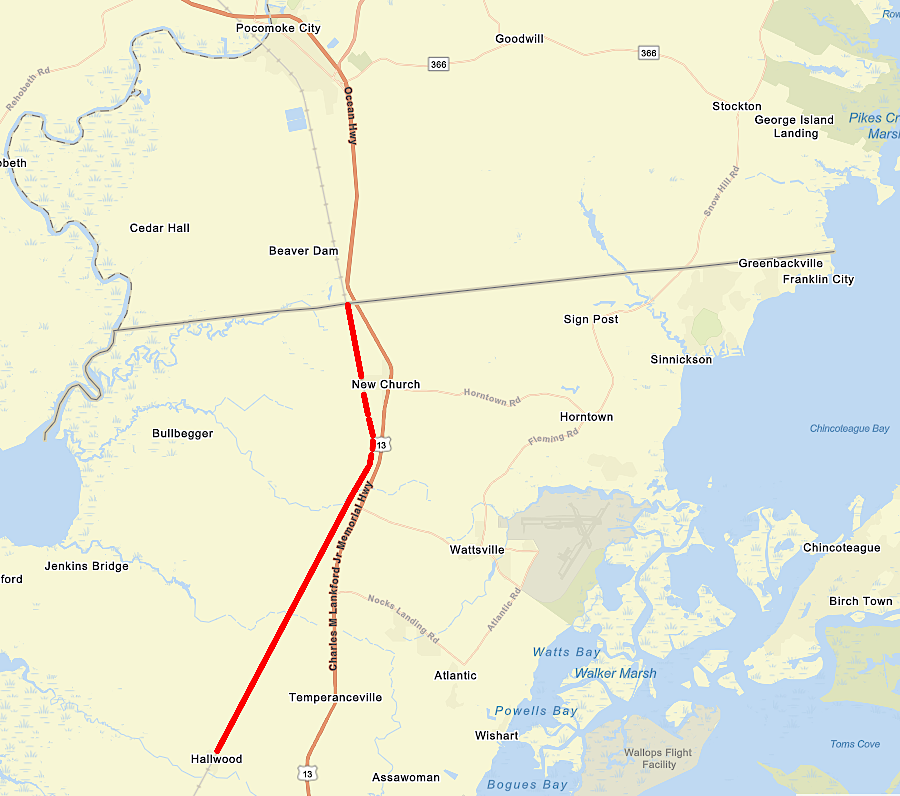
the Bay Coast Railroad ceased operations on April 30, 2018, but the Delmarva Central Railroad now provides service north of Hallwood to Pocomoke City, Maryland
Source: ESRI, ArcGIS Online

the Bay Coast Railroad ceased operations on April 30, 2018, but the Delmarva Central Railroad now provides service north of Hallwood to Pocomoke City, Maryland
Source: ESRI, ArcGIS Online
A remnant of the New York, Philadelphia and Norfolk Railroad has operated as the Delmarva Central Railroad since 2018. Service to Cape Charles was truncated that year, and now the trains stop at Hallwood in Accomack County.
The New York, Philadelphia and Norfolk Railroad, built in 1884, connected Northampton and Accomack counties to Baltimore, Philadelphia, and New York. Agricultural products and seafood could be shipped north by rail as well as steamboat. Shipments back to the Eastern Shore were minimal because of the small population and lack of industrial activity, though a "car float" barged railroad cars across the Chesapeake Bay to other railroads in Portsmouth and later to Virginia Beach. After Route 13 was paved and then the Chesapeake Bay Bridge-Tunnel opened in 1964, trucking replaced steamboats as the railroad's greatest competitor.
The Pennsylvania Railroad took control of the New York, Philadelphia and Norfolk Railroad in 1920, an action approved by the Interstate Commerce Commission two years later. The Pennsylvania Railroad morphed into the Penn Central in 1968. When the Penn Central went bankrupt in 1970, Eastern Shore officials hoped the 460 miles of track on the Delmarva (Delaware — Maryland — Virginia) peninsula would be acquired by the Southern Railway. It planned to continue existing operations, including service all the way to Cape Charles and Little Creek. All of the rail unions and Southern could not negotiate a labor agreement, however, and Conrail ended up with the Delmarva track in the Final Agreement ending the Penn Central bankruptcy in 1976.
Conrail would not maintain services south of Porter, Delaware because costs would exceed revenues. Track quality was poor; trains averaged only 8 miles per hour in Virginia. Derailments were so common that drivers on a road in Accomack County parallel to the track stayed in the far lane, since a train overturned and fell into the road.
To continue rail service to chicken plants, farm supply stores, and other Delmarva businesses, Maryland and Delaware arranged for service to continue south of the interchange with the Norfolk Southern Railway in Porter, Delaware. Northampton and Accomack counties acquired ownership of the track extending from Pocomoke City, Maryland to Little Creek in 1976. That acquisition included the car float used to barge railroad cars 26 miles across the Chesapeake Bay, plus the track and land at Little Creek in Virginia Beach. Northampton County officials continued to envision industrial development at Cape Charles, and rail service was essential for attracting new business there.
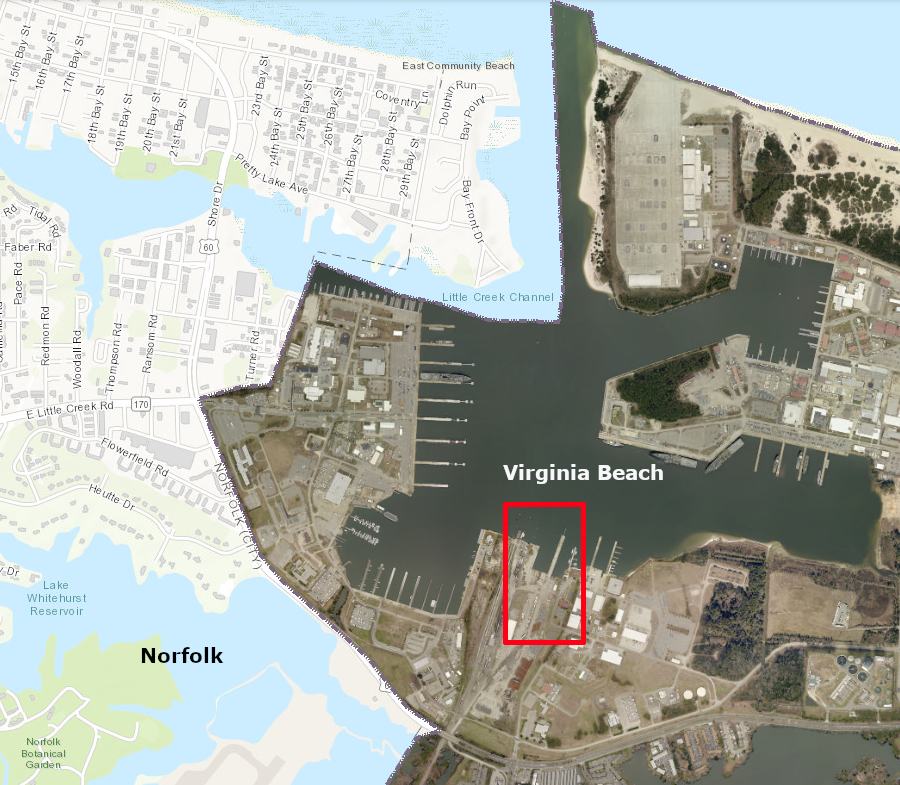
the car float ferry landing built originally by the New York, Philadelphia and Norfolk Railroad is in the City of Virginia Beach
Source: City of Virginia Beach, VBgov City Map
The two Virginia counties also acquired a private company, Canonie Atlantic Company, and in a complicated series of transactions Canonie Atlantic Company ended up owning the track south of Pocomoke City. The Accomack-Northampton Transportation District Commission owned all the Canonie Atlantic Company stock, so the counties owned the private company that owned the track. Canonie Atlantic leased the track to various short line railroad operators who had the equipment and expertise to manage freight train service.
First operator was the Virginia and Maryland Railroad, until it was replaced by the Eastern Shore Railroad. The Bay Coast Railroad (a subsidiary of Cassatt Management LLC) was the last operator to run trains all the way from Maryland to Little Creek. The company decided that it was not feasible to operate a railroad all the way down the Eastern Shore to Cape Charles and at Little Creek, and stopped operations on May 18, 2018. The timing of the decision caught local officials by surprise, but it was already clear that the freight traffic was inadequate to support the business.1
Bayshore Concrete Products, the largest private employer in Northampton County, had shipped only eight carloads in the last year. The company had shipped its fabricated concrete items by truck or barge, but the railroad had an opportunity to recapture traffic when the Chesapeake Bay Bridge-Tunnel decided to build a parallel tunnel at Thimble Shoals. Bayshore was started in 1961 to supply concrete for the orginal Chesapeake Bay Bridge-Tunnel, but did not get the contract for the second tunnel. That led to Bayshore shutting down operations at the end of 2018.
The Bay Coast Railroad lost its largest customer in late 2017. DCP Midstream had stored cars loaded with butane at Little Creek, before exporting it from a shipping terminal originally built to handle imports of propane.
Helena Chemical in Tasley had ordered only 13 cars of liquid fertilizer in 2018. Two other customers who lost service, Pep-up Gas and Sharp Energy, only used rail transportation between December-March.
Rail service on a small part of the Eastern Shore was restored within a month of Bay Coast Railroad shutting down. Delmarva Central Railroad, a shortline railroad owned by Carload Express, began to operate trains under lease from Canonie Atlantic in June, 2019. It serviced only the 15-mile stretch of rail from the south side of Taylor Street in Hallwood, Virginia in Accomack County north to Pocomoke City, Maryland. The carload count for the new operator on that segment in September, 2018 reached only 11 cars. The Buckingham Branch Railroad assumed responsibility for the Little Creek operations.
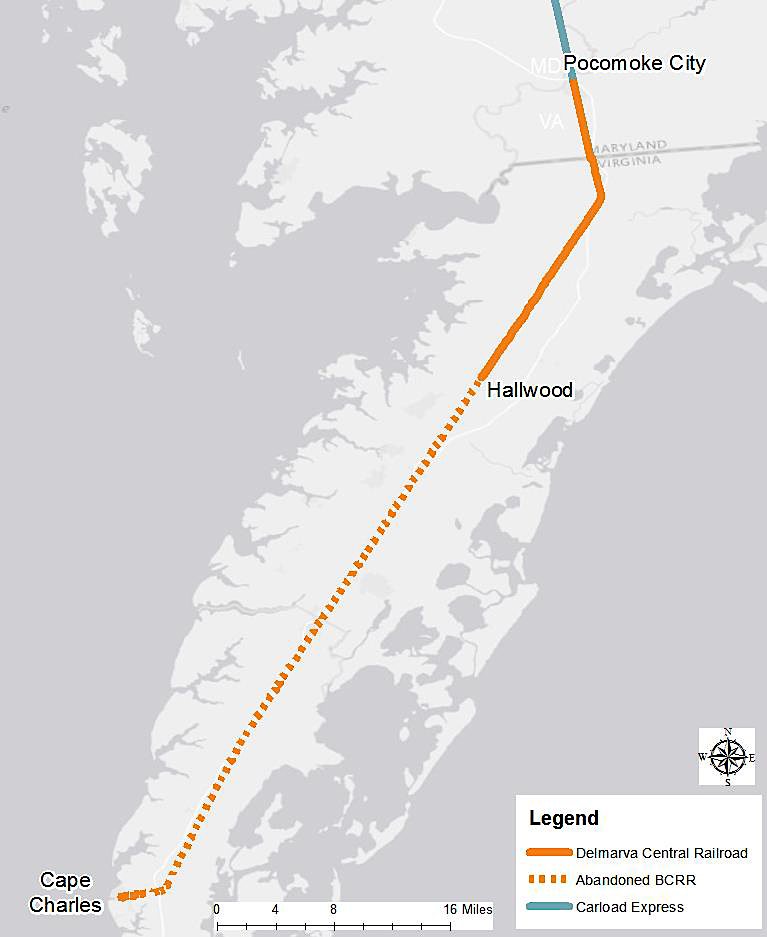
after the Bay Coast Railroad shut down in 2018, the Delmarva Central Railroad began operations to Hallwood
Source: Virginia Department of Rail and Public Transportation (DRPT), Rail Preservation Fund Grant Application - Delmarva Central Railroad (July 17, 2018)
Retention of the northern 15 miles of track meant Coastline Chemical and KMX Chemical, both in New Church, would continue to get rail service. Abandonment of the track leading to Cape Charles left customers south of Hallwood without rail service.
The owner of Associated Grain, Inc. in Parksley contended that Delmarva Central Railroad had overstated the cost to repair seven miles of track to continue freight service that town. Existing track met Class 1 standards and allowed trains to move at 10 miles per hour, and the businessman claimed the cost to upgrade the track to Class 2 standards allowing trains to move at 25 miles per hour was only $540,000 rather than $3.4 million.
Cost to replace aged ties was key. A Class 1 railroad required only five good ties for every 39 feet segment of track, while Class 2 required eight good ties. Upgrading to Class 2 between Lecato Station (Oak Hall) and Pocomoke City in 2019 required replacing 2,300 ties per mile. To save costs, the Delmarva Central Railroad left the five miles of low-use track between Lecato Station (Oak Hall) and Hallwood as Class 1, but still had to replace 700 ties per mile.
However, the Virginia Department of Rail and Public Transportation calculated that it would cost $4 million to bring up to Class 2 standards just the 15 miles of track between the Maryland border and Hallwood.
His offer to guarantee 750 carloads over three years was not sufficient for the Surface Transportation Board, which had to approve the track abandonment, to make Parksley the southernmost destination on the railroad. The Delmarva Central Railroad said it needed 700 carloads per year to make service economocally feasible.
Tapping into the rail preservation fund of the Virginia Department of Rail and Public Transportation required a 30% match by the railroad, or by Accomack and Northampton counties. A member of the Accomack County Board of Supervisors commented that operating the railroad to Cape Charles without enough customers was not viable, and trying to operate to Parksley would perpetuate the problem:2
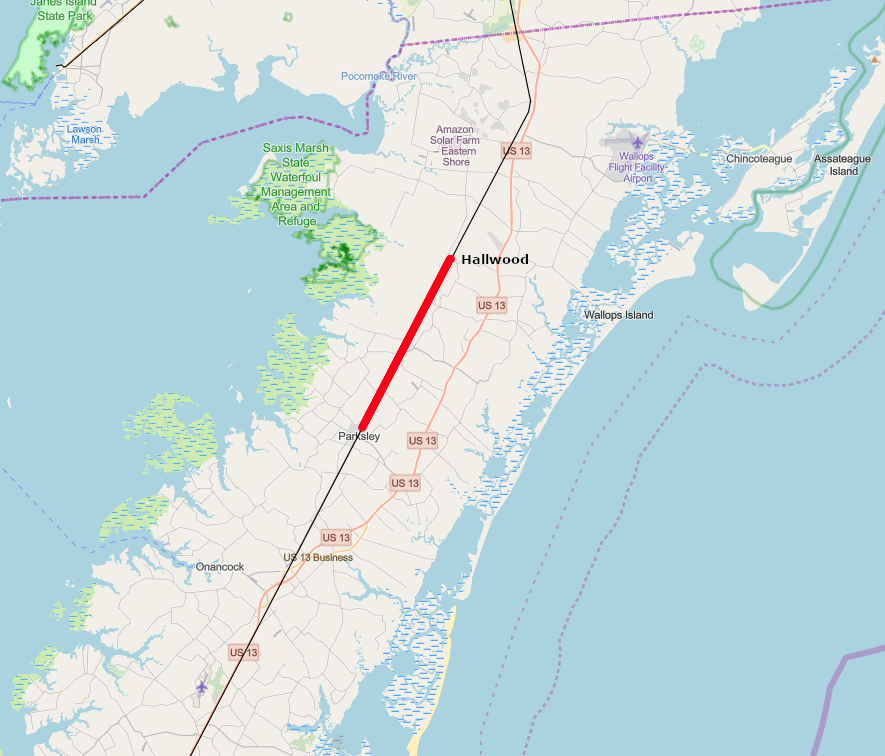
efforts to continue freight rail operations for seven miles between Hallwood and Parksley were unuccessful
Source: ESRI, ArcGIS Online
One locomotive was sold for scrap. The other, plus some rail cars, was donated to the Cape Charles Historical Society. The pilot house, rescued from a car float barge which had sunk in the Cape Charles harbor, was moved from the railyard to the Cape Charles Museum.
The rail barge "Nandua" was sold for an undisclosed price. The counties had invested $100,000 each, and the state had contributed $1,000,000, to repair damage to that barge after a 2010 storm.
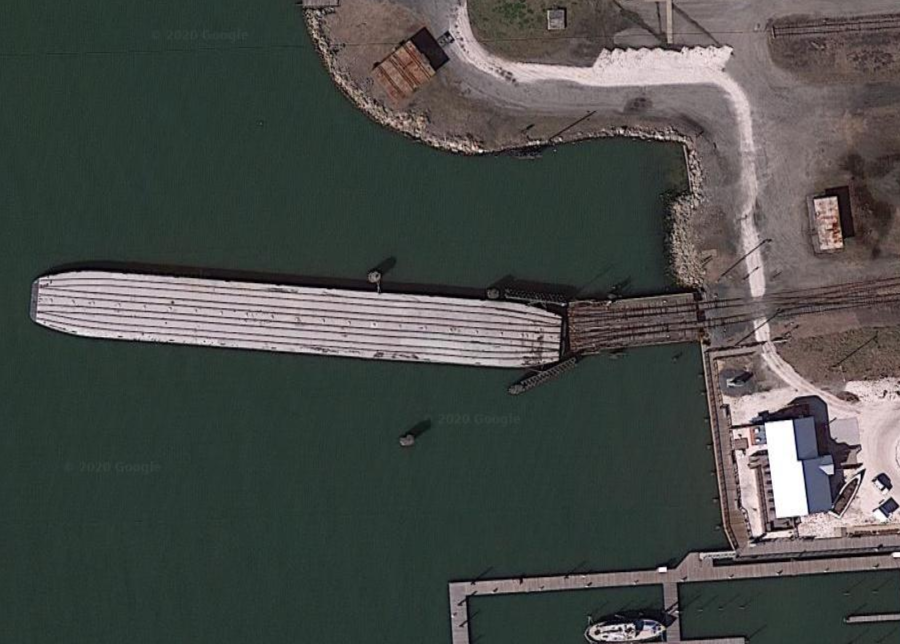
rail barge Nandua at Cape Charles wharf
Source: GoogleMaps
Upgrading the 49 miles of track on which service stopped would have cost $6 million. The chair of the Accomack-Northampton Transportation Commission, who simultaneously served as chair of the Canonie Atlantic board, said:3
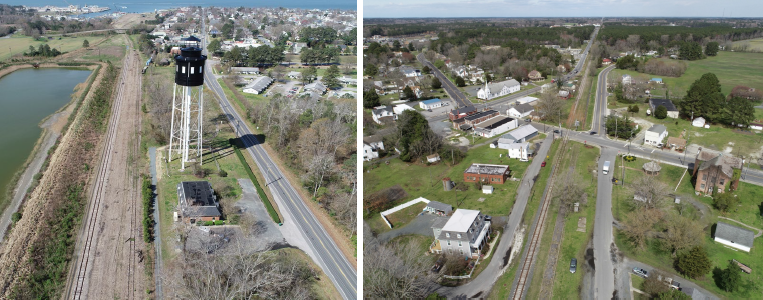
the track at Cape Charles, after rail operations ceased
Source: Virginia Department of Transportation (VDOT), May 5, 2020 Stakeholder Update Meeting
In 2022, Canonie Atlantic sold the St. Julian's yard in Norfolk to the Virginia Passenger Rail Authority. That yard had been built in 1929. It was needed because the Pennsylvania Railroad, which had assumed control of the New York, Philadelphia and Norfolk Railroad in 1920, moved the southern dock for barges that carried rail cars across the Chesapeake Bay from the dock at Cape Charles on the Delmarva Peninsula. Moving the southern dock from Port Norfolk (in Portsmouth, at the mouth of the Western Branch of the Elizabeth River) to Little Creek reduced the barge trip by 12 miles.
As part of the switch, the Pennsylvania Railroad acquired trackage rights from the original Norfolk Southern Railroad to use its Cape Henry route. From the new southern dock at Little Creek, Pennsylvania Railroad trains used the Cape Henry route to connect with the Norfolk and Western Railroad. The Pennsylvania Railroad built the St. Julian's Yard just northeast of the connection with the Norfolk and Western Railroad.
When Amtrak service started to Norfolk in 2012, St. Julian's Yard was used to service and store the passenger trains. In 2022, as part of the Transforming Rail in Virginia initiative, the Virginia Passenger Rail Authority purchased the yard for $2 million.4
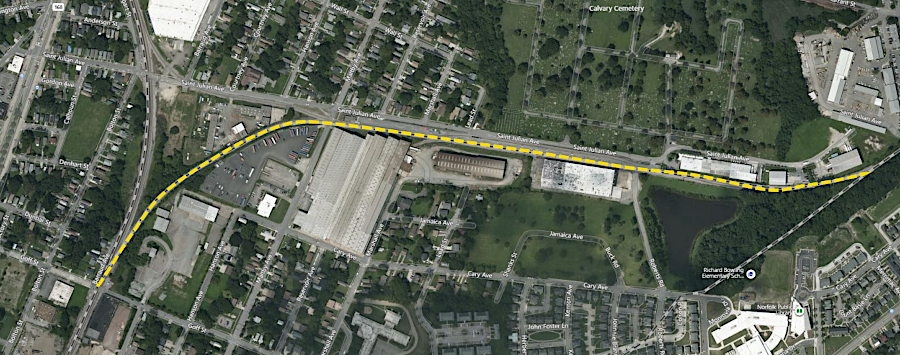
after the Bay Coast Railroad stopped running car floats across the Chesapeake Bay in 2018, the St. Julian's Yard became surplus property and was sold in 2022
Source: Virginia Passenger Rail Authority, St. Julian's Yard
Norfolk, VA (February 1, 2022)
A non-profit, New York, Philadelphia & Norfolk Railroad Resurrection, explored offering tourist excursions and then proposed to create a railroad museum. The county supervisors focused on converting the 49-mile stretch of railroad south of Hallwood, with its 40-foot wide right-of-way, into a hiking trail.
The Accomack-Northampton Transportation District Commission retained two valuable assets - the land and rail infrastructure in Little Creek, plus the 40 acres in Cape Charles used for the railyard.5
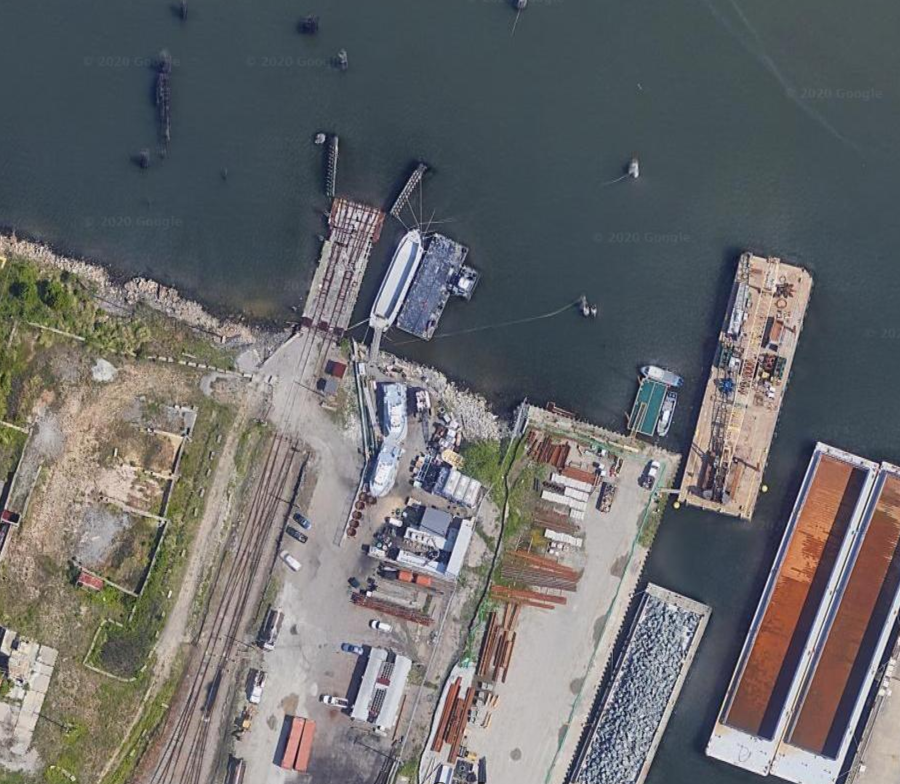
the Buckingham Branch Railroad took over operations at Little Creek wharf in 2019
Source: GoogleMaps
During the celebrartion of the centennial of the town of Cape Charles in 1986, the chair of the Northampton County Board of Supervisors commented:6
In 2019, a different chair of the Northampton County Board of Supervisors acknowledged that operations on the track built by the New York, Philadelphia and Norfolk Railroad would cease, but asserted that the heritage dating back to 1884 would be remembered:7
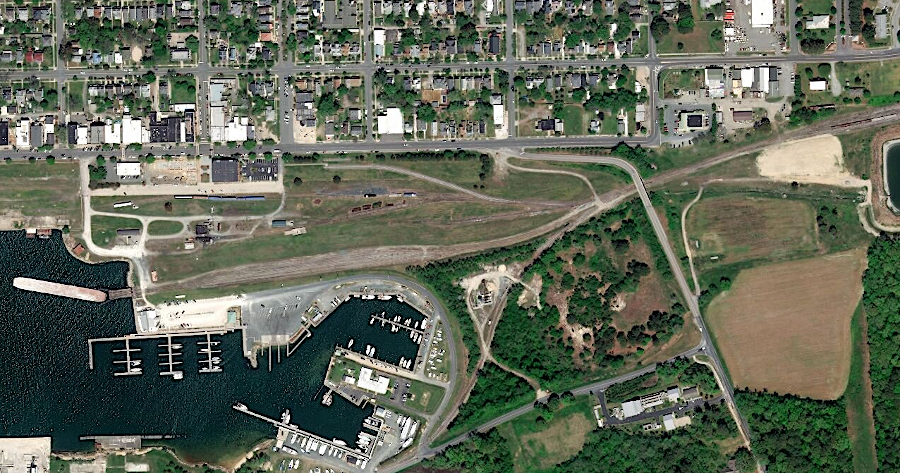
Cape Charles wharf, after the shutdown of the Bay Coast Railroad
Source: ESRI, ArcGIS Online
The decision to pull up the tracks between Cape Charles-Hallwood and convert the railroad bed into a biking/hiking trail was made easier by experience, and by a survey indicating nearly 90% of Eastern Shore residents would use it. The annual "Tour Between the Waters" biking event sponsored by the Citizens For A Better Eastern Shore had steadily grown in popularity since 1992. In 2020, despite the COVID-19 pandemic, the event planned for 1,000 riders.
Based on the Eastern Shore Bike Plan adopted in 2004 and updated in 2014, five miles of the branch line between Cape Charles and the former Kiptopeke ferry had already been converted into the Southern Tip Bike & Hike Trail. The opening of Phase 2 in 2019 linked the Eastern Shore of Virginia National Wildlife Refuge to Kiptopeke State Park, with two more phases scheduled to complete the connection to the Town of Cape Charles.
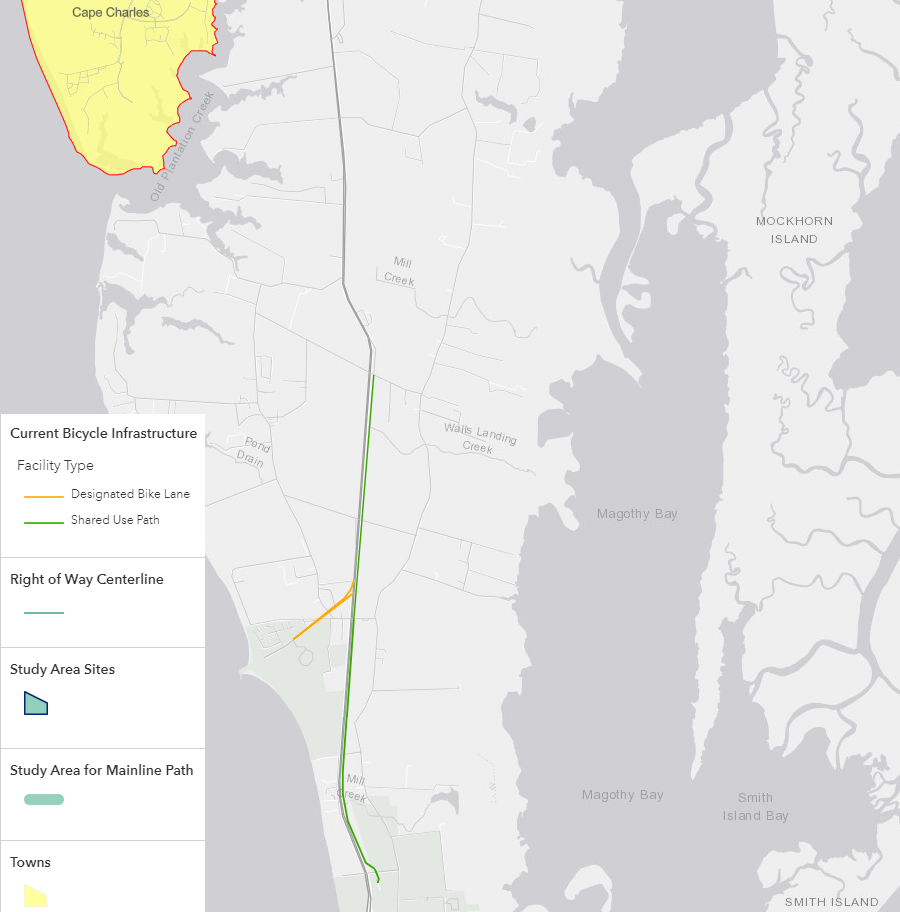
the Southern Tip Bike & Hike Trail initially linked Eastern Shore of Virginia National Wildlife Refuge to Kiptopeke State Park
Source: Virginia Department of Transportation, Eastern Shore Rail to Trail Study, Interactive Map of Project Area
The first two phases were funded and constructed by the U.S. Fish and Wildlife Service. State funding was sought for the remaining phases. At the time, the Governor of Virginia was Ralph Northam, a native of Accomack County.
The coversion of 49 mile of railroad would create the longest rail-to-trail project in Virginia. The possibility of using the railroad right-of-way to connect the trail to the Chesapeake Bay in the town of Cape Charles was abandoned after Canonie Atlantic, the private railroad owned by the Accomack-Northampton Transportation District Commission, decided to sell the rail yard.
The Virginia Department of Transportation estimated the cost to replace 49 miles of track with a 10' wide asphalt trail would cost $25 million. It increased the projection later, adding an alternative soft surface path and a 40% contingeny estimate, to $43 million.8
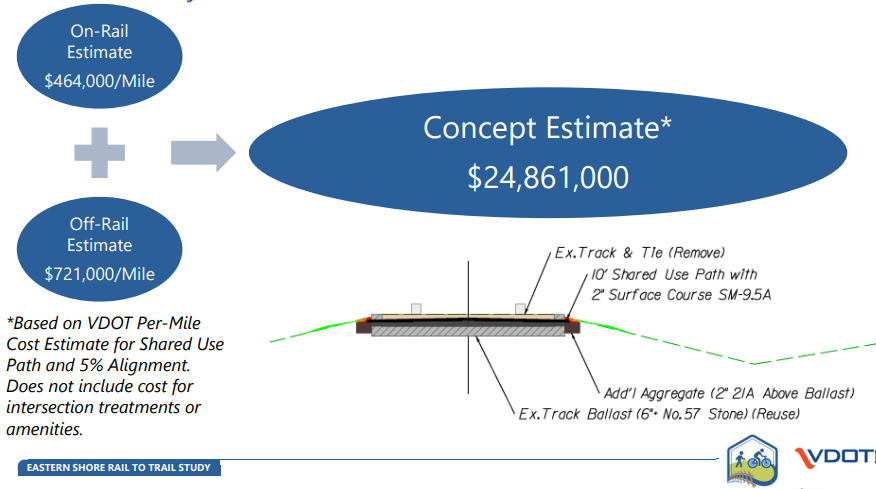
just paving a 10' wide path between Cape Charles-Hallwood was projected to cost $25 million
Source: Virginia Department of Transportation (VDOT), Eastern Shore Rail to Trail Study - Stakeholder Meeting #3 (June 2020)
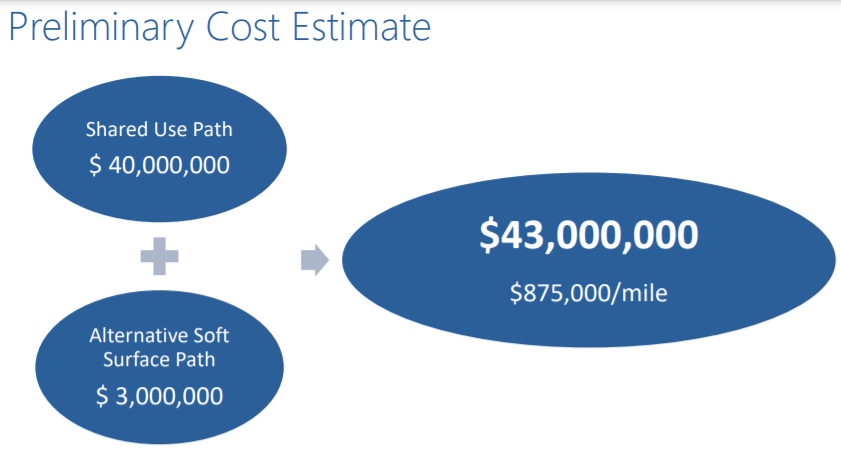
including all trail-related costs plus a 40% contingency, the proposed rail-to-trail project would cost almost $1 million/mile
Source: Virginia Department of Transportation, Eastern Shore Rail to Trail Study, Study Work Group Meeting #4 (September 2020)
The state agency completed the Eastern Shore Rail to Trail Feasibility Study in 2020.
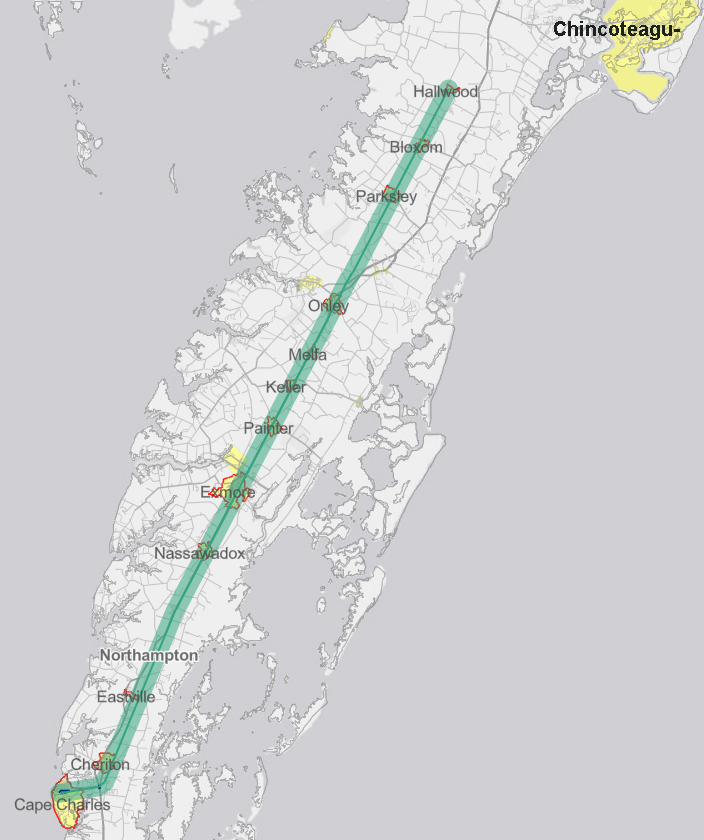
the proposed rail-to-trail project would connect almost every town on the Eastern Shore, but had no link to Chincoteague
Source: Virginia Department of Transportation, interactive map, Eastern Shore Rail to Trail Study
The study made clear the benefits of converting the track to trail:9
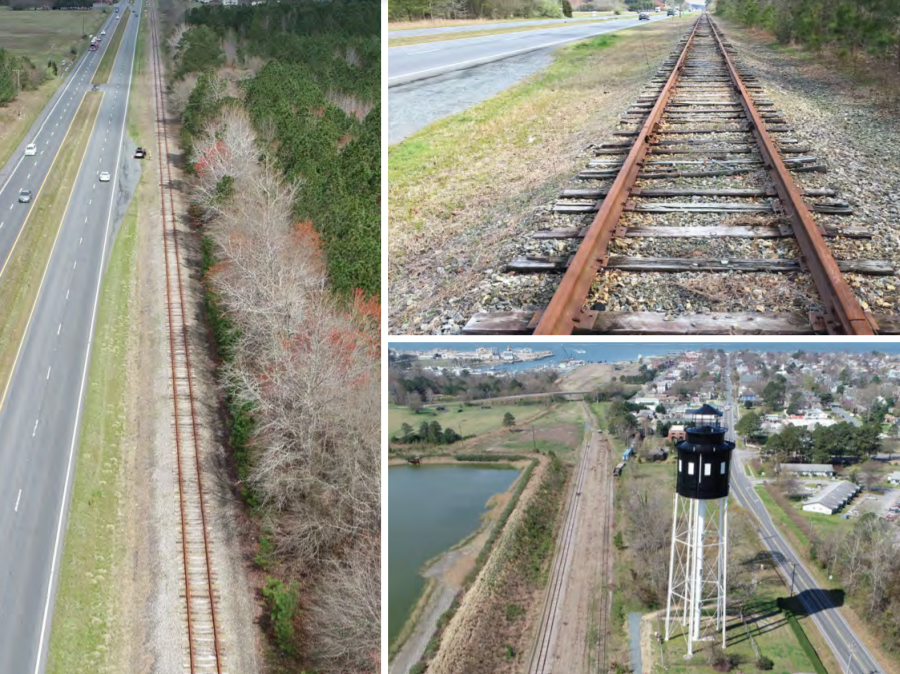
the Eastern Shore Rail to Trail Feasibility Study was completed in 2020
Source: Virginia Department of Transportation, Eastern Shore Rail to Trail Feasibility Study
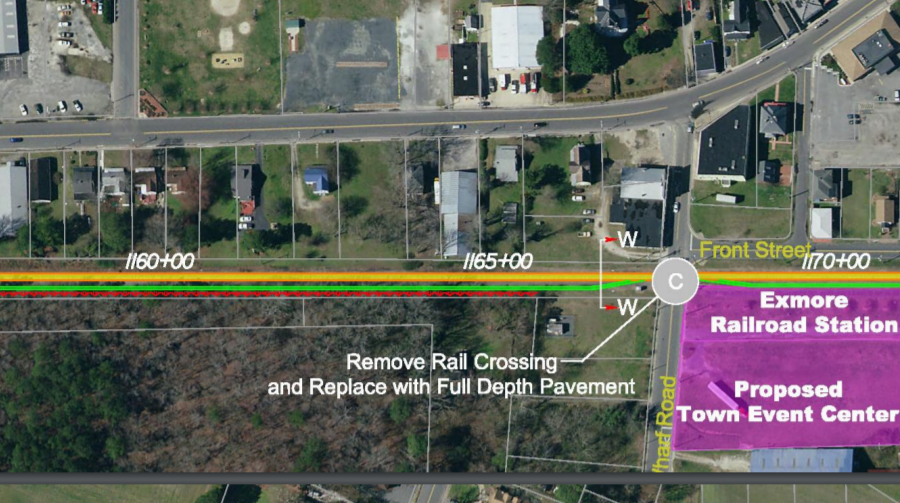
the proposed rail-to-trail project was intended to stimulate tourism as welll as provide bike/pedestrian mobility for residents
Source: Virginia Department of Transportation, Eastern Shore Rail to Trail Study, Study Work Group Meeting #4 (September 2020)
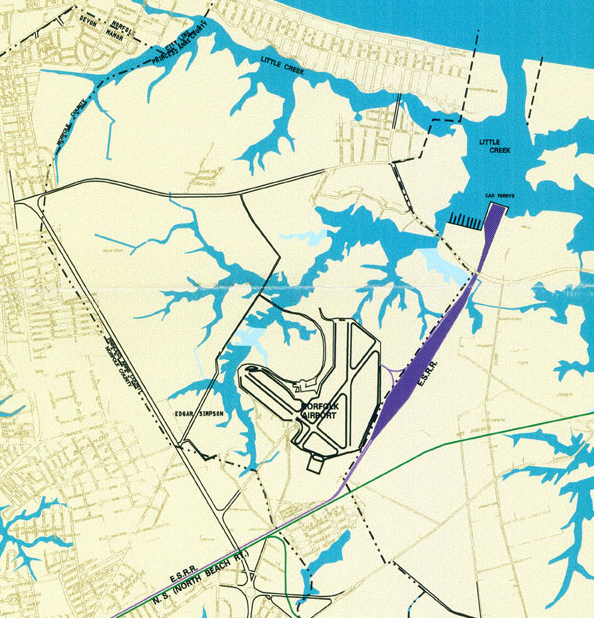
the Bay Coast Railroad (formerly known as the Eastern Shore Railroad) barged rail cars to Little Creek, where the railroad connected to CSX and Norfolk Southern until 2018
Source: Norfolk & Portsmouth Belt Line Railroad Map